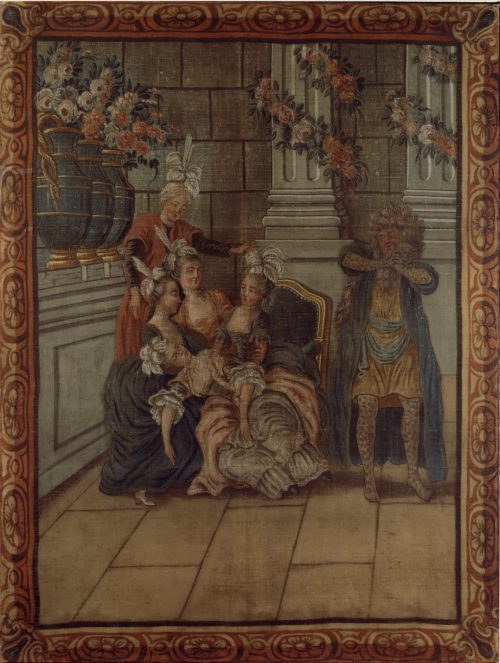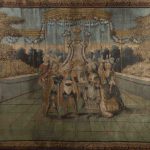9583 A UNIQUE SET OF FIVE FAUX TAPESTRY PANELS DEPICTING SCENES FROM GRÉTRY’S OPÉRA-COMIQUE, ZÉMIRE ET AZOR French. Circa 1775. Measurements: Large Panel: Height: 87″ (221 cm); Width: 112″ (284.5 cm). Four Smaller Panels: Height: 87″ (221 cm); Width: 66″ (168 cm)

Research
Of tempera on canvas. Each panel depicting a vignette from the tale of Zémire et Azor showing elegant ladies and gentlemen in period costume variously swooning and indicating horror at the sight of the beastly Azor. All set within a painted faux gilt frame. Stretchers replaced, minor restorations, water stain to base of one panel.
A favorite opera-comique of Marie-Antoinette, Zémire et Azor was composed by Andre Modeste Grétry (1741-1813) and its libretto was written by Jean-Francois Marmontel (1723-1799). It was first performed at Fontainebleau in November of 1771 and was dedicated to Madame du Barry, and would later be performed for the emperor Napoleon. The story was an adaptation set in Persia of Jeanne-Marie Leprince de Beaumont’s tale ‘La Belle et Bete’ (‘Beauty and the Beast’) first published in 1756.
The tale is told that Marie-Antoinette, upon passing Grétry and Marmontel in the gallery at Fontainbleau, bestowed all her praise on Grétry, whom she made her music director in 1774, telling him “that during the night she had dreamed of the enchanting effect of the trio by Zémire’s father and sisters behind the magic mirror.” Grétry cried out “Ah! my friend, excellent music may be made of this,” but Marmontel, having received no compliments, apathetically replied “And execrable words.”1
The costume and décor illustrated in the panels follow the much imitated, extravagant A La Turc style promoted by Marie-Antoinette, which represented the height of fashion and opulence. It has been suggested that the five panels were conceived as preliminary designs or maquettes for tapestries, probably for one of the great French factories such as Aubusson or Beauvais.
Footnotes:
1. Hamel, Frank. The Women at Fontainbleau. London: Eveleigh Nash, 1909. 358.





Comments are closed.